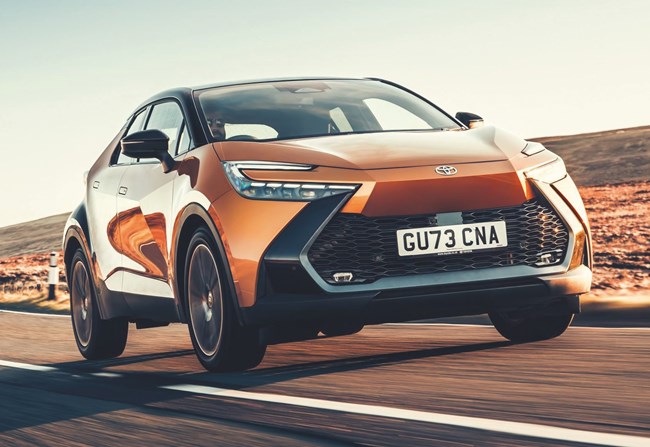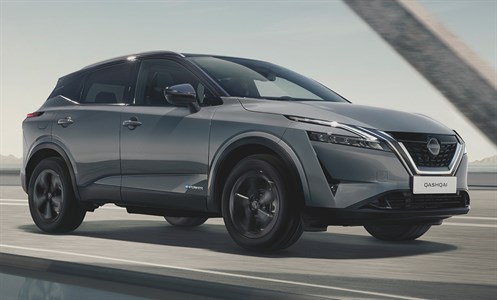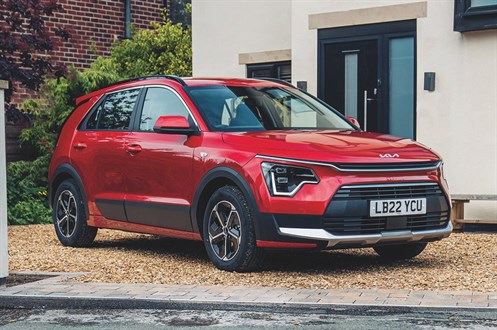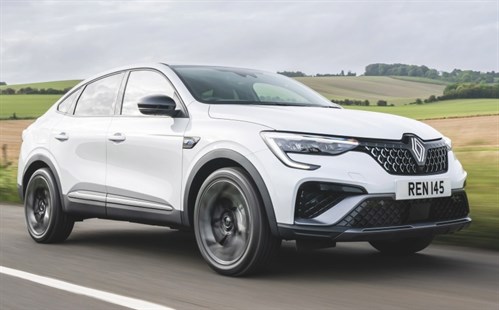We use cookies to ensure that we give you the best experience on our website. If you continue without changing your settings, we will assume that you are happy to receive all cookies on the Business Car website. However, if you would like to, you can change your cookies at any time

The start point for the best source of fleet information |
Best in Class: Mid-size SUVs
Date: 07 February 2024 | Author: Martyn Collins

Toyota C-HR
Toyota claims that according to customer research, its original C-HR was a breakthrough against mid-size SUVs, with 840,000 sales in Europe and up to 18,000 in the UK alone.
Now there's a new, second-generation C-HR, and those buyers will be pleased to know, that this time round, the basic shape remains unchanged, although it looks much more modern and bolder.
At the front, the new C-HR is the second model to get Toyota's 'hammerhead' face, which on this car equals high-set, double-deck front LED headlights, and large lower grille with sharp detailing. There's more honed metal work down the flanks, wide arches to give it a chunkier stance, and flush-fit door handles. At the back, there's a high-set light bar, with the model's name integrated into it. Range-topping models are offered with a bi-tone + paint finish, where the roof and rear quarters of the car are finished in gloss black.
Despite looking longer, this C-HR is 35mm shorter, and 15mm has been taken from the height, although this version is 45mm wider, with the chunkier arches and bigger wheels equalling a more assertive stance.
Inside, there's no more room for the C-HR, so while space and the driving position are fine in the front of this Toyota, rear space remains more of a challenge. We like the curvy new dashboard design that continues into the front doors. Made from quality-feeling, soft-touch plastic, it's home to the new 12.3in digital driver display and a new central infotainment screen measuring 8in or the larger 12.3in we tried. Thankfully despite the big screen, Toyota has included enough physical controls for most drivers to be at home.
Like all Toyota models, the C-HR is only available with electrified powertrains in 1.8 and 2.0-litre hybrid forms. There will however be a plug-in hybrid version available this month. Toyota is predicting that the 140hp, 1.8-litre, which develops 185Nm of torque, and a 0-62mph acceleration time of 10.2 seconds, will be the key seller for fleet, and this is the engine we focus on here.
Mated with the latest evolution of Toyota's e-CVT transmission, its slick and refined nature generally works well with the laid-back feel of the performance. However, it is less fun when asked to work harder, where it gets thrashier and noisier.
Choose this Toyota, and you'll benefit from a decent 26% BIK figure, but the C-HR can still only manage second place behind the Kia in this regard.
The frugal 58.9mpg figure perfectly shows why Toyota's hybrid system just works. But it doesn't take top spot in this group! Instead, again it comes 5.3mpg behind the winning Kia.
The news is no better when you compare this C-HR, even in mid-spec Design spec, on P11D value, which at £34,455 is the most expensive car of this set. Despite being worth 47% of its original value after three years, this is only good enough for fourth place, with the seemingly all-conquering Kia Niro coming top with just 2% more. All these residual figures are close, with the Renault and Nissan tied for second on just 1% more in. In terms of depreciation, the Toyota comes third, ahead of the Nissan but behind the Kia and Renault.
To the C-HR's credit, it does boast the lowest SMR figure here at £2,098, in Design trim, with the Kia just behind in second place, and the Renault and Nissan bringing up the rear.
Despite that low SMR cost, the Toyota is only able to come third in this comparison overall with its 44.63p cost-per-mile figure.
Toyota C-HR 1.8 Design
P11D: £34,455
CO2 (tax): 108g/km (26%)
BIK 20/40% a month: £149/£298
Fuel consumption: 58.9mpg
National Insurance: £103
First year VED: £185
Subsequent VED: £170
Engine size/power: 1,798cc + 70kW motor/140hp
AFR: 16p
Residual value: 47%
Depreciation: £17,754
Fuel costs: £6,930
SMR: £2,098
Cost per mile: 44.63p

Nissan Qashqai
The car that was instrumental in the crossover revolution, the Nissan Qashqai, remains one of the most popular on the market. The current third-generation car was revealed just over two years ago, but the clever E-Power self-charging hybrid version was launched last summer.
The E-Power features a 1.5-litre three-cylinder petrol engine which supplies power to a 140kW electric motor. Outside, from the front, the Qashqai looks sharp and modern with the slashed headlights that are high up in the body and the latest family grille.
Inside, the Qashqai driving position is excellent - with plenty of space even for the tallest. Access to the rear seats is also good, with the rear doors that open to 85 degrees, and space is adequate for two adults. Although the battery does reduce the boot space to a still decent 504 litres.
The E-Power hybrid system works well enough, but its residual value (48%) and P11D figures (£33,765), are the only places where the Nissan comes close to leading this set. Its 48.55p cost-per-mile figure leaves it some way behind the others here.
Nissan Qashqai 1.5 E-Power Acenta Premium
P11D: £33,765
CO2 (tax): 117g/km (28%)
BIK 20/40% a month: £157/£315
Fuel consumption: 54.3mpg
National Insurance: £108
First year VED: £255
Subsequent VED: £170
Engine size/power: 1,477cc + 140kW motor/190hp
AFR: 13p
Residual value: 48%
Depreciation: £18,540
Fuel costs: £7,049
SMR: £2,901
Cost per mile: 47.48p

Kia Niro
The latest Niro is longer, wider, and taller, but the basic crossover hatchback shape remains unchanged from the original. That's where the similarities with the rather tamely styled previous version end.
Inside, the feel is modern, spacious, and obviously influenced by Kia's EV6. There's plenty of space throughout, and a big 475-litre boot, so this Kia is practical too.
On the road, this Kia offers a tidy drive with a comfortable ride. To sum up, the new Niro has its own sense of style and looks interesting when compared to rivals.
The Niro has the best mpg at 64.2mpg, has the lowest NI figure at £85, and the most affordable P11D figure at £29,835, as well as the lowest depreciation figure at £14,840, holding 49% of its original value. As such, the Kia comes top, with the lowest cost-per-mile figure of 38.95p of this group.
Kia Niro 1.6 GDi 2 Hybrid
P11D: £29,835
CO2 (tax): 100g/km (25%)
BIK 20/40% a month: £124/£248
Fuel consumption: 64.2mpg
National Insurance: £155
First year VED: £155
Subsequent VED: £170
Engine size/power: 1,580cc + 32kW motor/141hp
AFR: 13p
Residual value: 49%
Depreciation: £14,840
Fuel costs: £6,389
SMR: £2,144
Cost per mile: 38.95p

Renault Arkana
With its coupe-SUV styling, like the Toyota C-HR, you couldn't call the Renault Arkana a conventional rival.
The Arkana does look unusually slick with its tall and curvy roofline and that long tail, yet this Renault is surprisingly practical, with decent interior space. Although we are focussing on the E-Tech 145 here, which gets a slightly smaller 480-litre boot with a useful two-level floor that can be extended by folding the 60/40 back seat.
This Renault shares all of its underpinnings with the Captur, so the E-Tech 145 engine is not new, but it it is proven. Around town, the electric motor starts quickly, so this Renault spends most of its time in full EV mode. Out of town, you will be pleased that transitions between the engine and electric motor are smooth, as the non-turbocharged 1.6-litre petrol
takes over and, in our opinion, works hard. 'Slow' and 'thrashy' will best describe the performance, with the 0-62mph acceleration taking 10.8 seconds - and it is particularly noisy while getting there.
The Arkana's unusual styling is obviously a hit with buyers, as with its £15,865 depreciation, it's the second lowest depreciator behind the winning Kia. At £31,065 and 25%, this Renault has the second lowest P11D and BIK figures, too. As such, the Arkana has a 41.86p cost-per-mile figure, finishing in a solid second place.
Renault Arkana 1.6 E-Tech 145 Esprit Alpine
P11D: £31,065
CO2 (tax): 110g/km (27%)
BIK 20/40% a month: £139/£279
Fuel consumption: 57.6mpg
National Insurance: £96
First year VED: £175
Subsequent VED: £120
Engine size/power: 1,598cc + 36kW and 18kW motors/145hp
AFR: 10p
Residual value: 48%
Depreciation: £15,865
Fuel costs: £7,049
SMR: £2,204
Cost per mile: 41.86p











